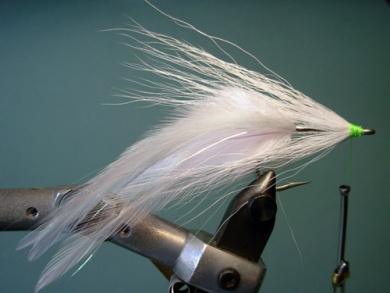Lefty Kreh, the creator of this fly, is one the most recognized fly fishermen in the world.He made this fly in the late 50´s to fish saltwater; he was looking for a streamer that would be easy to cast and would not wrap around the bend of the hook. But let’s read Lefty´s own words about what was View more...Lefty Kreh, the creator of this fly, is one the most recognized fly fishermen in the world.He made this fly in the late 50´s to fish saltwater; he was looking for a streamer that would be easy to cast and would not wrap around the bend of the hook. But let’s read Lefty´s own words about what was to become the most famous pattern for saltwater fly fishing:"I'm going to design a fly that won't foul on the cast! It will have a fish shape, but can be made in many lengths. You can vary the color combinations; it will also swim well but when lifted for the back cast, it will be sleek and have little air-resistance. I only hoped it would work and didn't consider it might become a part of fly-fishing history. The first Lefty's Deceivers were pretty simple. They were tied with a wing of four to eight saddle hackles tied in at the bend of the hook, and they had a simple bucktail or calf tail collar at the front of the hook. The fly was all white, which is still one of the best all-round colors. It may have been two or three years before I added other colors. As I recall the first color change I made was to have a white wing and red collar. Other combinations followed.”Usually it is tied in hook sizes ranging from #2 to #4 and the most popular colors are white and yellow with darker tones for the body (green, red, blue, pale blue), though sometimes totally black is used too.Here in Argentina, it has been used to fish for trout with good results; being tied in smaller sizes and darker colors. It´s also a great fly when fishing for Golden dorados, and it´s been used in saltwater to catch other species such as anchovies.Here, I will show the step-by-step instructions for the White and Green version of it, which involves fewer steps but still maintains its design.
Move the mouse over the image to zoom in the fly.
Touch the image to zoom in the fly.

List of materials
MaterialsHook: TMC 811S or similar. Sizes # 2 to # 4/0.Thread: 3/0 green.Tail: Three or four pairs of white rooster saddle feathers, V-shaped and tied with the tips pointing out.Flash: Some Flashabou strips or pearled Crystal Flash, tied at each side at the base of the tail feathers.Body: Flat Silver Tinsel.Wing: White deer hair tail and a chartreuse strap over it. Some tiers use peacock herl as a topping.Belly: White deer hair strap.Throat: Red Flashabou or Crystal Flash.Head: Thread color View more...MaterialsHook: TMC 811S or similar. Sizes # 2 to # 4/0.Thread: 3/0 green.Tail: Three or four pairs of white rooster saddle feathers, V-shaped and tied with the tips pointing out.Flash: Some Flashabou strips or pearled Crystal Flash, tied at each side at the base of the tail feathers.Body: Flat Silver Tinsel.Wing: White deer hair tail and a chartreuse strap over it. Some tiers use peacock herl as a topping.Belly: White deer hair strap.Throat: Red Flashabou or Crystal Flash.Head: Thread color must be similar to the green one of the fly body.Eyes: White with a black pupil. Adhesive and covered by a fine layer of epoxi or painted with varnish or acrylic.
Steps
Step 1
Tie three or four pairs of white rooster saddle feathers, these must be V-shaped and tied with the tips pointing out.
Step 2
Tie some Flashabou strips or pearled Crystal Flash at each side of the fly, at the base of the tail feathers.
Step 3
Shape the Flat Silver Tinsel body.
Step 4
To make the wing, tie at the tip of the hook a strap of the white bucktail hair.
Step 5
To shape the belly, tie another strap of white bucktail hair on the lower section.
Step 6
Tie over the wing a chartreuse strap of bucktail hair.
Step 7
For the throat, tie a bit of red flashabou. Even out the head with thread to add volume to the fly.
Step 8
Add stick on eyes to the head of the fly. Whip finish and cemment.








